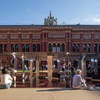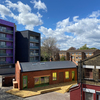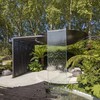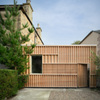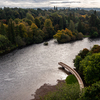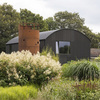Future By Design Protostructure
Subscribe now to instantly view this image
Subscribe to the Architects’ Journal (AJ) for instant access to the AJ Buildings Library, an online database of nearly 2,000 exemplar buildings in photographs, plans, elevations and details.
Already a subscriber? Sign in
241LFW5YLXOJHQ1_P1620861admed
All photos by Tom Morton Download Original
Future by Design was the British Council’s Architectural project for COP26, , the Argyll Arts Residency Cove Park, which Arc won with the Ghanaian designer Mae-ling Lokko.
The project was designed and built in the summer of 2021 in the run-up to COP26, alongside a sister project in Accra, Ghana.
Arc brought together an interdisciplinary group of young designers from the Glasgow School of Art and Royal Botanic Gardens, Edinburgh to explore the future of architecture in an era of climate crisis, in partnership with a parallel group in Ghana.
What emerged through a series of workshops was a zero-carbon, innovative timber gridshell protostructure imitating the conditions of the lost Scottish Rainforest, a generative strategy of environmental renewal for a degraded, post-farming landscape. A learning space rests on repurposed concrete foundations, with furniture grown from mycelium and agro-waste.
Built mainly by the students themselves, the project tested the boundaries of contemporary design and construction practice to address systemic issues of current gender inequality and historic racism. It focused on the challenges that young designers will face in their careers to 2050 and the leadership and cooperation needed to deliver change.
Both countries found they faced similar challenges of flooding from climate change and developed localised responses through community partnerships. Strategies to cope with increasing rainfall in west Scotland signpost a future zero-carbon and resource-equal construction sector.
Delivered in the midst of Covid, this was an extraordinarily challenging project for all involved. The experience and learning gained was the main outcome, the structure a physical manifestation of the power of creativity and cooperation as an Architectural response to climate crisis. Chris Stark, CEO of the UK Climate Change Committee described it as 'a structure that represents the change that we have to go through'.
Please watch our short film at https://youtu.be/7N-CIvcOCiU
Data
- Begun: Jul 2021
- Completed: Sep 2021
- Floor area: 66m2
- Sector: Arts and culture
- Total cost: £14,400
- Funding: British Council, Future BY Design (Architecture Design Fashion) competitive programme fund, Arts & Business Scotland grant
- Tender date: May 2021
- Address: Cove Park, Peaton Hill, Cove, Argyll and Bute, G84 0PE, United Kingdom
Professional Team 
- Architect: Arc Architects
- Client: Francesca Bertolotti-Bailey, director of public programme and facilities, Cove Park
- Structural engineer : David Narro Associates
- Main contractor: Rebearth

















